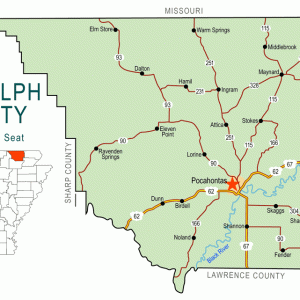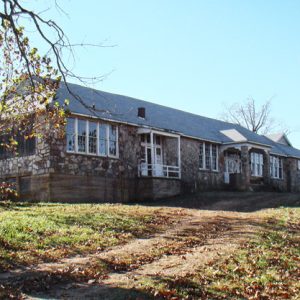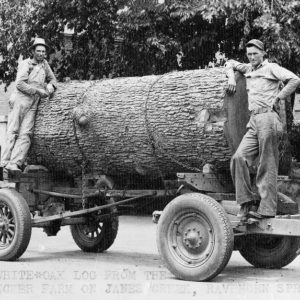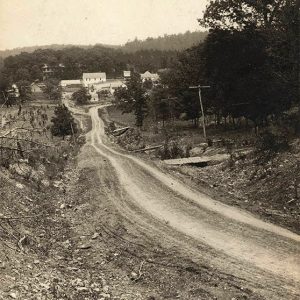calsfoundation@cals.org
Ravenden Springs (Randolph County)
| Latitude and Longitude: | 36°18’59″N 091°13’21″W |
| Elevation: | 443 feet |
| Area: | 1.16 square miles (2020 Census) |
| Population: | 119 (2020 Census) |
| Incorporation Date: | August 18, 1881 |
Historical Population as per the U.S. Census:
|
1810 |
1820 |
1830 |
1840 |
1850 |
1860 |
1870 |
1880 |
1890 |
1900 |
|
– |
– |
– |
– |
– |
– |
– |
– |
– |
– |
|
1910 |
1920 |
1930 |
1940 |
1950 |
1960 |
1970 |
1980 |
1990 |
2000 |
|
189 |
191 |
175 |
200 |
197 |
126 |
107 |
230 |
131 |
137 |
|
2010 |
2020 |
|
|
|
|
|
|
|
|
|
118 |
119 |
|
|
|
|
|
|
|
|
The town of Ravenden Springs is located in the easternmost extension of the Ozark Mountains in western Randolph County, an area that is among the oldest settled areas of Arkansas. In 1809, John Janes, a Revolutionary War veteran, settled on the large creek that now bears his name just south of present-day Ravenden Springs and established a trading post there. One of the earliest mail routes in Arkansas ran from Dry Springs on the Missouri border to Lanes’s Store (successor to Janes’ Trading Post) to Batesville (Independence County). Two villages grew up around Lanes’s Store—Walnut Hill and Kingsville—both of which disappeared in time.
In 1820, Caleb Lindsey started what has been documented as the first school in Arkansas. “School Cave” was in the rock walls of the canyon of Hall’s Creek, which runs through Ravenden Springs. The cave continued to be used as a school for most of the nineteenth century. That same year, his nephew, Eli Lindsey became the first Methodist circuit rider in Arkansas, riding the Spring River Circuit from the Ravenden Springs area into Independence County. In 1818, Caleb Lindsey founded the first official Baptist church in Arkansas in Columbia Township east of Ravenden Springs.
The town of Ravenden Springs was established in 1880 as the result of a recurring dream of a Methodist minister, the Reverend William Bailey. Bailey suffered from a stomach ailment for many years. One night, he reportedly dreamed that there was a spring near the bottom of the rock walls of Hall’s Creek Canyon on which the Baileys had lived for many decades. He dreamed that he climbed down the canyon, found the spring, drank from it, and was cured of his stomach problem. He dreamed the same dream for three successive nights. He then climbed down the canyon and repeated his actions from the dream. He continued drinking from the spring and soon was cured of his stomach ailment. Hence the nickname “The Dream Town” was soon applied to the community that grew up around the spring.
According to a 2008 retrospective in the Arkansas Democrat-Gazette, five springs were discovered in the canyon—each one, it was claimed, had a unique healing property: Stomach Spring, Eye Spring, Arthritis Spring, Kidney Spring, and Heart Spring. The Stomach Spring was later analyzed and found to contain water with some unusual amounts of trace elements—especially lithium, magnesium, aluminum, and iodine—along with carbonic acid. However, earlier sources cite a different number of springs, usually two. An October 24, 1937, article in the Arkansas Gazette mentioned two springs, the second of which offered remedies specific for eyes. An article in the November 6, 1939, Arkansas Democrat also mentioned two springs but attributed to them a range of curative powers.
The story of Bailey’s dream and the spring was widely circulated, and an area railroad man, Captain R. D. Welsh, visited the spring. Welsh was impressed with what he found there and soon went to St. Louis, Missouri, and organized a stock company. He then returned to the spring and laid out a town around it. Welsh’s stock company built the forty-room Southern Hotel above the canyon in 1883, and the spa town of Ravenden Springs was born.
Soon, “taking the waters at Ravenden Springs” became a passion for people in northeast Arkansas and as far away as St. Louis and Chicago, Illinois. It was especially popular with the families of planters who lived in the Delta lowlands east of the Black River. Located at a higher elevation than the swampy wetlands to the east, Ravenden Springs was considerably cooler in the summer’s heat. The spa also had no mosquitoes and so avoided the malaria that plagued the flatlands in the summertime. Other hotels sprang up, too. Soon, the summer population of Ravenden Springs exceeded 1,800.
Other attractions in Hall’s Creek Canyon soon became popular with visitors as well. Over eons, the creek carved a canyon with solid stone walls approximately 200 feet high. Waterfalls existed all along the creek with excellent swimming holes below them that furnished summer-long recreation for visitors. Other features were the School Cave and the much larger Elephant Cave at the bottom of a high stone bluff. Near the Elephant Cave, high up on the canyon wall, was the Raven’s Den. The den, a shallow cave, was observed to be the nesting place of Corvus corax, the common raven, in the 1820s. The ravens were never seen there again after 1861, but their nesting spot gave its name to the area and the town.
Further down the canyon is the Needle’s Eye, a crack in the rock canyon wall large enough for a person to enter and climb with moderate difficulty to the top of the canyon. Another feature is the Lone Rock, a pinnacle of solid rock that has separated from the canyon wall and stands as a monolith, rising some seventy-five feet from the canyon floor.
During its boom years as a spa, Ravenden Springs had numerous business establishments, a post office, the Lone Rock Bank, doctors, lawyers, and other professionals. The Atkins Hotel was built in 1902—the building stands empty as of 2009. The spa began to lose favor as a summer resort in the 1930s, and the town went into a decline in population and business activity that persists into the twenty-first century.
Ravenden Springs today still has a small business community including Bailey’s Garage and Body Shop, Wells’ Pallet Mill, and Tom’s Small Engine Shop. The town still has its post office, as well as four churches—Methodist, Church of Christ, and two Baptist churches. Most residents of the town now work in ranching and timber activities or commute to Pocahontas (Randolph County) for work. Arkansas Highway 90 from Pocahontas to Ravenden (Lawrence County) via Ravenden Springs was paved in 1958.
The community school was consolidated with that of other nearby communities in 1949. The 1941 flagstone/craftsman school was placed on the National Register of Historic Places in 2004 and now houses the Ravenden Springs Community Museum, which tells the history of the area.
For additional information:
Cook, Regina. History of Randolph County, Arkansas. Dallas: Curtis Media Corp., 1992.
Dalton, Lawrence. The History of Randolph County. Little Rock: Democrat Printing and Lithographing Company, 1946.
Harris, Peggy. “Cave Believed to be First School in Arkansas.” Arkansas Democrat-Gazette. November 23, 2008, p. 2B.
“Health Is Wealth.” Arkansas Gazette, May 24, 1887, p. 8.
Taylor, Rev. Joseph G. “Arkansas’s Dream Town.” Arkansas Gazette Sunday Magazine, October 24, 1937, p. 3.
Bill Carroll
Five Rivers Historic Preservation, Inc.
 Randolph County Map
Randolph County Map  Ravenden Springs Community Center
Ravenden Springs Community Center  Ravenden Springs
Ravenden Springs  Ravenden Springs Cotton
Ravenden Springs Cotton  Ravenden Springs Logging
Ravenden Springs Logging  Ravenden Springs View
Ravenden Springs View  Southern Hotel
Southern Hotel 




The story of Ravenden Springs is fascinating! You folks must invite Mr. Dovish from Exploring Arkansas to visit the area and show off this interesting region! I for one am wanting to know more about the history and actual place known as Ravenden Springs.